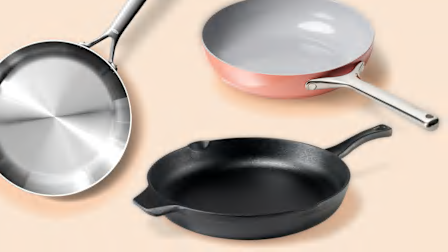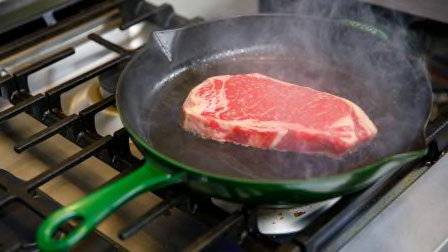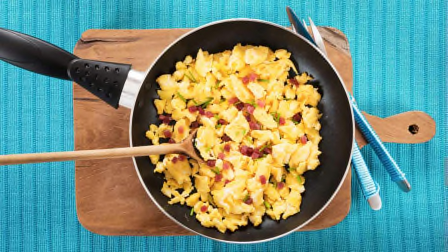Best Copper Frying Pans
Our tests included a Brooklyn upstart and two French classics
When you shop through retailer links on our site, we may earn affiliate commissions. 100% of the fees we collect are used to support our nonprofit mission. Learn more.

Julia Child famously had 30 copper pots hanging on the wall of her kitchen in Cambridge, Mass., where three of her many cooking shows were filmed. “It did my heart good to see rows of gleaming knives and copper pots at the ready,” Child wrote in her autobiography, “My Life in France.”
Gleam is just part of the charm of copper cookware. The real attraction? Superior heat conductivity.
“Copper pans heat up quickly and evenly and respond to heat better than other cookware,” said Cindy Fisher, the technician in charge of CR’s copper cookware tests. “Copper gives you more control of the temperature. When you remove the pan from the heat, it cools down quickly.”
To check the heating evenness of the pans we rated, we cooked thin crepes, and to test how well the pans sauté, we cooked potatoes until they were fork-tender. We also cooked food that requires controlled heat. “We made risotto and banana tarte tatin, and melted white chocolate in the pans, and they all did well,” Fisher said.
While copper pans are popular with professional chefs and some serious foodies, home cooks have been a little slower to add them to their collections. For one thing, they’re expensive. The copper frying pans in our tests range from $150 to $540 compared with about $35 to about $180 for a stainless steel skillet. And myths surrounding copper cookware may make you wary.
One such myth is that copper, as a material, is unsafe for cooking. That’s based on the fact that it’s a reactive metal. Cooking acidic foods (tomatoes, vinegar) in an unlined copper pan can leach copper into the food and, over time, result in a rare condition called copper toxicity. But the pans on the market today, including all of those we tested, are lined with a nonreactive metal, such as tin or stainless steel, that makes them perfectly safe to cook in.
The other knock against copper is that it’s hard to clean. While they aren’t as easy to clean as nonstick pans, in our tests we found that cleaning frying pans made of copper was similar to cleaning those made of other materials, such as stainless steel. Using a little soap and water does the job. To prevent the outside from getting tarnished, dry it thoroughly. If it does become discolored, as copper tends to do, “all you need is a good copper cleaner on the exterior,” Fisher said.
Consumer Reports no longer tests copper frying pans, but we do continually test stainless, carbon steel, cast iron and nonstick skillets. Below is a rundown of copper frying pans from our past tests, listed in alphabetical order. For more on these and other pans in our tests, see our cookware and frying pan ratings and buying guide.
The least expensive pan in this mix, the Bottega Del Rame Copper has a flaw shared by many less costly pots and pans: handles that tend to get wobbly over time. That brought its score down a bit. On the plus side, this 10.25-inch pan scored well in cooking evenness, and the handles stay cool to the touch when you’re preparing a dish. Sauté performance is average, on a par with the other pans here. The pan weighs 3.7 pounds and is lined with tin.
The Brooklyn Copper Sauté, $480, is made by a small 10-year-old company in—where else?—Brooklyn. Each piece is handmade, which accounts for the high price. The 9.5-inch pan was the only one in our tests to earn an excellent rating for cooking evenness. Sautéing performance was on a par with the other copper pans in our tests. The handle is sturdy and stays cool to the touch when the pan is in use.
At 6.7 pounds, it’s the heaviest copper pan we tested. Because it’s lined with tin, which is a soft metal, it can’t take the high heat that other pans can. The company cautions that heating it above 400° F can damage the tin lining. That means you have to be careful if you want to start a dish on the stovetop and move it to the oven. The pans are sold only on the company’s website.
This 200-year-old French company has a full line of copper cookware, including the De Buyer Inocuivre Tradition. This 9.5-inch pan was a bit of a disappointment, however. Cooking evenness was only so-so, as was sauté performance. And it was a bit trickier to clean than the other copper pans we tested. But the handle is very sturdy and stays cool to the touch as you cook. The 3.3-pound pan is lined with stainless steel.
Made in France since 1830, Mauviel is one of the better-known brands of copper cookware. The 10.2-inch Mauviel 6544.26 M250C earns a very good rating for cooking evenness and, like the other pans we tested, is just average at sautéing. The handle is sturdy and stays cool to the touch during cooking. This 4.1-pound pan is lined with stainless steel, and it’s oven-safe to 450° F. As we mentioned, copper pans aren’t cheap, and the price of this one is in keeping with the competition.



































